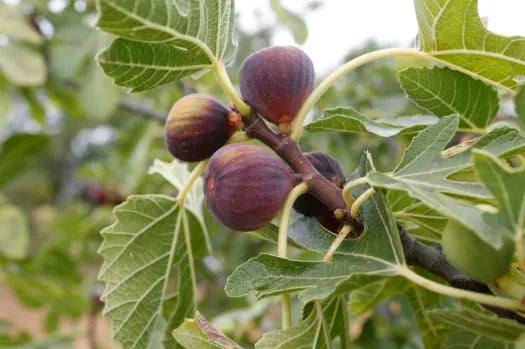The Anjeer (Fig) Tree: Cultivation and Benefits
Discover the fascinating world of the anjeer (fig) tree, from its cultivation process to its numerous health benefits. Learn how to grow anjeer and incorporate it into your diet.
Introduction
Anjeer, also known as figs, are among the most nutritious and delicious fruits. Originating from the Middle East and Western Asia, the fig tree has been cultivated for thousands of years. This article explores how anjeer is grown, its benefits, and how you can use it in your daily diet.
The Anjeer Tree
The fig tree (Ficus carica) is a member of the Moraceae family. It is a deciduous tree that typically grows in warm, dry climates. Here’s an in-depth look at the anjeer tree and its cultivation:
Climate and Soil Requirements
- Climate: Fig trees thrive in regions with hot summers and mild winters. They require a lot of sunlight and prefer temperatures between 15°C to 30°C.
- Soil: Figs grow best in well-drained soils with a pH between 6.0 and 6.5. They can tolerate slightly acidic to slightly alkaline conditions but prefer loamy soils rich in organic matter.
Planting and Propagation
Figs can be propagated through seeds, cuttings, or air layering. Here’s a step-by-step guide on planting fig trees:
- Seeds: While growing figs from seeds is possible, it is less common due to the long germination period.
- Cuttings: This is the most popular method. Take a cutting of about 12-18 inches from a healthy tree and plant it in well-drained soil. Ensure the cutting has at least three nodes (points where leaves emerge).
- Air Layering: This involves wounding a part of the branch, wrapping it with moist moss, and covering it with plastic until roots develop.
Care and Maintenance
Proper care ensures healthy growth and abundant fruit production. Here are key aspects of fig tree maintenance:
- Watering: Fig trees need regular watering, especially during the growing season. Water deeply but avoid waterlogging.
- Fertilization: Apply a balanced fertilizer during the growing season. Organic compost can also enhance soil fertility.
- Pruning: Prune fig trees annually to remove dead or diseased branches and to maintain shape and size.
- Pest and Disease Control: Common pests include fig beetles, nematodes, and aphids. Regular inspection and organic pest control methods can help manage these issues.
How Anjeer (Fig) is Formed
The formation of figs is a unique process involving an intricate relationship with fig wasps. Here’s how it happens:
- Pollination: Figs are pollinated by tiny fig wasps. The wasps enter the fig through a small opening, lay their eggs, and in the process, pollinate the flowers inside.
- Development: Once pollinated, the flowers inside the fig develop into seeds. The fig itself swells and matures, turning into the sweet fruit we enjoy.
- Harvesting: Figs are typically ready for harvest when they are soft to the touch and droop slightly from their stems. This usually occurs in late summer to early fall.
Benefits of Anjeer
Figs offer a range of health benefits, making them a valuable addition to any diet. Here’s why:
Rich in Nutrients
Figs are packed with essential nutrients such as fiber, vitamins, and minerals. Per 100 grams of fresh figs, they provide:
- Calories: 74 kcal
- Carbohydrates: 19.18 grams
- Sugars: 16.26 grams
- Fiber: 2.9 grams
- Protein: 0.75 grams
- Fat: 0.30 grams
- Vitamin A: 142 IU
- Vitamin C: 2 milligrams
- Calcium: 35 milligrams
- Magnesium: 17 milligrams
- Potassium: 232 milligrams
- Iron: 0.37 milligrams
Supports Digestive Health
The high fiber content in figs promotes healthy digestion and prevents constipation. Regular consumption of figs can support a healthy digestive system.
Heart Health
Figs are rich in potassium and magnesium, which help regulate blood pressure and support heart health. The dietary fiber in figs can also help lower cholesterol levels.
Antioxidant Properties
Figs contain antioxidants like polyphenols and flavonoids, which combat oxidative stress and reduce inflammation, protecting the body against chronic diseases.
Bone Health
The calcium and magnesium in figs contribute to maintaining strong bones and preventing osteoporosis.
How to Use Anjeer
Figs can be enjoyed in various forms and incorporated into different dishes:
- Fresh Figs: Eat them as a snack or add them to salads for a sweet touch.
- Dried Figs: Enjoy dried figs as a portable snack or use them in baking and cooking.
- Fig Jam: Spread fig jam on toast or use it as a filling for pastries.
- Fig Smoothies: Blend figs with other fruits and yogurt for a nutritious smoothie.
- Salads and Desserts: Add figs to salads or use them as a topping for desserts like ice cream and yogurt.
Effect Time
The health benefits of figs can vary depending on individual health conditions and consumption patterns. Generally, improvements in digestion can be noticed within a few days to a week of regular consumption. Benefits such as improved heart health and better bone density may take several weeks to months of consistent intake.
Conclusion
The anjeer (fig) tree is a remarkable plant that offers a plethora of health benefits through its delicious fruits. Here’s a quick recap:
- Tree Cultivation: Requires warm climate, well-drained soil, and proper care for optimal growth.
- Fig Formation: Involves a unique pollination process with fig wasps.
- Health Benefits: Supports digestion, heart health, bone strength, and provides antioxidants.
- Usage: Versatile in culinary applications, from snacks to salads and desserts.
- Effect Time: Varies from a few days to several months depending on the benefit.
Incorporating anjeer into your diet can enhance your overall health and well-being. Whether you enjoy them fresh or dried, figs are a nutritious and delicious addition to your meals.
Where to Buy
If you're looking to add high-quality anjeer to your diet, you can purchase them online:




